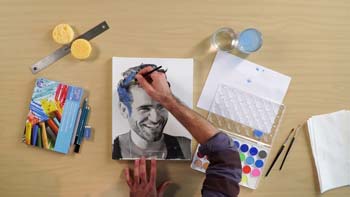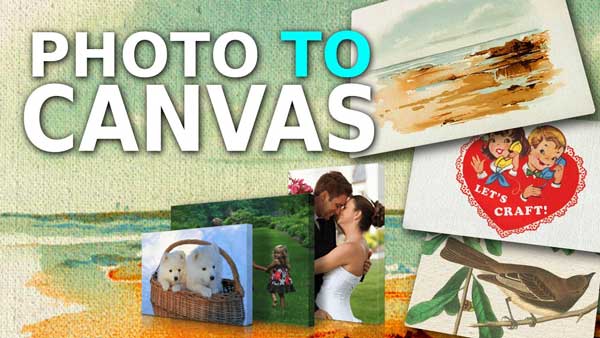How to Put a Photo on Canvas By Yourself-Easy Method
Canvas has been used for a long time for different purposes. The strength and durability of the material make it suitable for various functions.
One of the most common uses of the canvas is painting. It has been used for centuries by famous artists to do their paintwork which is still in good condition in museums across the world.
It has found an even more interesting function as photographic images are now transferred or printed on canvas. It is also suitable for simple mounting of photographs.
Table of Contents
Why Use Canvas?
You may wonder why someone would use canvas for photography work while the traditional paper seems to work just fine. Canvas does not look to the eye like it would present as well as paper when it comes to photography.
However, canvas actually shares some qualities with paper when it comes to photography and has certain unique qualities that give it an advantage over paper as a printing material for photos.
Advantages Of Using Canvas For Photography Work
Disadvantages Of Using Canvas For Photography
How To Put Photos On Canvas
For this process you will need:
Method
- 1Get your canvas and nail it to the frame; the frame should be slightly smaller to allow the canvas to wrap around the edges.
- 2Spread the medium gel across the canvas evenly though not to the sides.
- 3Place the photo on the canvas making sure it is well centered. It should be slightly bigger in size than the canvas. Note that the photo should be mirrored when printing so that it appears the right side up when transferred onto the canvas.
- 4Gently but firmly press the photo to the canvas evenly.
- 5Turn the canvas upside down and use the hard card (an old credit card or something similar would do) to repeat the pressing but this time on the underside and ensure you straighten all creases and remove air bubbles.
- 6Let the medium dry for at least 24 hours. During this time the project should not be disturbed at all.
- 7After the drying period get the pair of scissors and cut the hanging edges of the photo as close as possible to the frame.
- 8Use your file to even the edges of the cut photo until it is at the same level as the canvas.
- 9Get your water in a spray bottle and spray lightly onto the canvas. Start peeling off the paper slowly; it will not come off at once but is a process you will have to repeat several times before your photo is clearly revealed. Do not stress yourself removing every bit of paper; small pieces will remain here and there, and that is what gives it that rustic, unique look
- 10Spray a coat of clear varnish to give it a gloss and to protect the photo.
If you took notice the picture only covers the front part of the canvas. Now let’s see how to make it wrap around the whole frame; in this case, the photo size needs to be reasonably bigger than the canvas:
This additional feature takes twice as long to achieve but gives a unique look.
You can also add an effect by applying medium gel over the complete product and using a cloth to dub lightly over.
Mounting A Photo On A Canvas

This does not involve transferring the image onto the canvas but simply pinning it to a canvas that has been spread across a frame.
Method
Place your photo evenly on the canvas and fold it over the edges using tacking pins. You could choose to spray a layer of clear varnish to give it a gloss.
Putting images on canvas using nail polish remover
This is an inexpensive technique that requires cheap nail polish remover to do the job.
Requirements
Method
- 1Place the photo on the canvas and secure it using the masking tape.
- 2Soak the cotton cloth in nail polish remover; do not soak it too much. It should be well soaked but not dripping.
- 3Press the soaked rug over the image. Progressively do this until you cover the whole surface.
- 4Let the nail polish remover dry and repeat the process until the image is transferred onto the canvas.
This method can also be used to transfer images onto other surfaces such as wood and tiles.
How to transfer a colored image onto canvas

The general method works but does not give similar clarity and quality with colored photos.
Requirements
Method
- 1Lay down the canvas and place a tissue paper on top of it. Trim it to the exact size as the canvas.
- 2Put your iron on high heat setting and iron the tissue paper or serviette removing all creases.
- 3Use the tissue as your printing paper; put it into the laser printer and print the image to be transferred.
- 4Apply your gel medium evenly across the canvas covering all corners
- 5Place your image on the canvas and use a foam brush to gently remove any creases and air bubbles; you have to be extra careful because of the fragile qualities of tissue paper.
- 6Let the medium dry.
- 7You can add a protective layer of medium gel or clear varnish.
You can choose to either have the photo at the exact size of the front side of the canvas; in this case, you will need to neatly cut and file the edges of the photo.
You may also choose to wrap it around the frame in which case you will need to apply the medium gel to the sides of the frame and press the image onto it just like you did in the first phase.
Transferring photos onto canvas is an easy and very entertaining art technique. It is relatively very cheap and can be easily taught through online tutorials.
The product is unique and refreshing. It can also be used in just about any setting. Try it out today. You will enjoy it.

